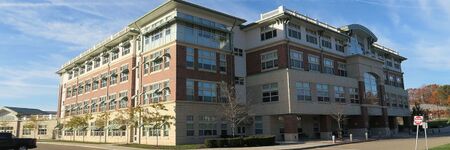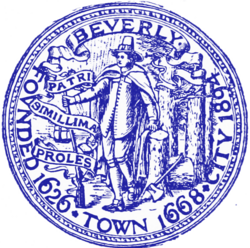Beverly MA: Difference between revisions
Created page with "{{Infobox municipality |image=Beverly High School.jpg |image_caption=Beverly High School |image_seal=Seal_of_Beverly,_Massachusetts.png |municipality=City |established=January 1, 1668 |area=22.59 sq.mi |elevation=36 ft |population=42670 |website=http://www.beverlyma.gov/ |timezone=EST |description=Beverly is a city in Essex County, Massachusetts, and a suburb of Boston. The population was 42,670 at the time of the 2020 United States Census. A resort, residential, and man..." |
No edit summary |
||
| Line 12: | Line 12: | ||
|description=Beverly is a city in Essex County, Massachusetts, and a suburb of Boston. The population was 42,670 at the time of the 2020 United States Census. A resort, residential, and manufacturing community on the Massachusetts North Shore, Beverly includes Ryal Side, North Beverly, Montserrat, Beverly Farms and Prides Crossing. Beverly is a rival of Marblehead for the title of being the "birthplace of the U.S. Navy". | |description=Beverly is a city in Essex County, Massachusetts, and a suburb of Boston. The population was 42,670 at the time of the 2020 United States Census. A resort, residential, and manufacturing community on the Massachusetts North Shore, Beverly includes Ryal Side, North Beverly, Montserrat, Beverly Farms and Prides Crossing. Beverly is a rival of Marblehead for the title of being the "birthplace of the U.S. Navy". | ||
}} | }} | ||
Native Americans inhabited what would become northeastern Massachusetts for thousands of years before European colonization of the Americas. At the time of contact in the early 1600s, the area that would become Beverly was between an important Naumkeag settlement in present-day Salem and Agawam settlements on Cape Ann, with probable indigenous settlement sites at the mouth of the Bass River. During the early contact period, virgin soil epidemics ravaged native populations, reducing the indigenous population within the present boundaries of Beverly from an estimated 200 to less than 50 if any survivors. | |||
Europeans under Roger Conant's leadership first colonized the area in 1626 as part of the Massachusetts Bay Colony. Initially part of Salem, Beverly would be set off and officially incorporated in 1668, when it was named after Beverley, the county town of the East Riding of Yorkshire, England. Surviving from the settlement's early history is the Balch House, built, according to dendrochronological testing performed in 2006, about 1679. | |||
English colonists did not initially seek permission from indigenous inhabitants to settle in Beverly, however when Charles II revoked colonial charters to establish the Dominion of New England in 1684, Beverly joined a number of Massachusetts municipalities in seeking out heirs to local sachems and paying them ex post facto in order to establish a right to the land. So it was that in 1686 the town selectmen agreed to pay six pounds, six shillings, and eight pence to three grandchildren of Masconomet, last sachem of the Agawam. They did not pay this sum until 1700 | |||
Latest revision as of 19:41, April 14, 2024
- Members
Beverly is a city in Essex County, Massachusetts, and a suburb of Boston. The population was 42,670 at the time of the 2020 United States Census. A resort, residential, and manufacturing community on the Massachusetts North Shore, Beverly includes Ryal Side, North Beverly, Montserrat, Beverly Farms and Prides Crossing. Beverly is a rival of Marblehead for the title of being the "birthplace of the U.S. Navy".
Activities

|
Beverly Public Schools Electric Busses | |
| Beverly Public Schools in Massachusetts has implemented a project utilizing their electric school buses as on-demand power plants. By using bidirectional chargers, the buses' large batteries can both charge and send energy back to the grid, providing backup power during high-demand periods. | ||
Details
Native Americans inhabited what would become northeastern Massachusetts for thousands of years before European colonization of the Americas. At the time of contact in the early 1600s, the area that would become Beverly was between an important Naumkeag settlement in present-day Salem and Agawam settlements on Cape Ann, with probable indigenous settlement sites at the mouth of the Bass River. During the early contact period, virgin soil epidemics ravaged native populations, reducing the indigenous population within the present boundaries of Beverly from an estimated 200 to less than 50 if any survivors.
Europeans under Roger Conant's leadership first colonized the area in 1626 as part of the Massachusetts Bay Colony. Initially part of Salem, Beverly would be set off and officially incorporated in 1668, when it was named after Beverley, the county town of the East Riding of Yorkshire, England. Surviving from the settlement's early history is the Balch House, built, according to dendrochronological testing performed in 2006, about 1679.
English colonists did not initially seek permission from indigenous inhabitants to settle in Beverly, however when Charles II revoked colonial charters to establish the Dominion of New England in 1684, Beverly joined a number of Massachusetts municipalities in seeking out heirs to local sachems and paying them ex post facto in order to establish a right to the land. So it was that in 1686 the town selectmen agreed to pay six pounds, six shillings, and eight pence to three grandchildren of Masconomet, last sachem of the Agawam. They did not pay this sum until 1700


